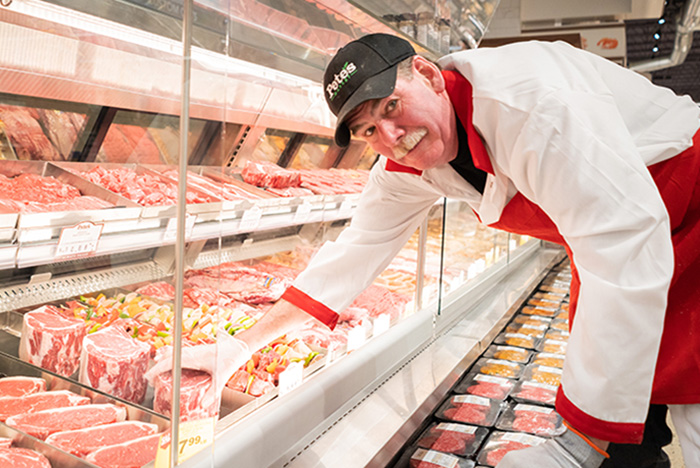
For meat lovers who enjoy cooking at home, quality beef offers a world of delicious opportunities. Whether grilled, roasted, or broiled, beef is versatile, nourishing, and satisfying. But broccoli beef stir-fry is quite different from pot roast, and both require a specific cut in order to be their best. To be blunt, knowing the nuances of beef cuts is critical to mastering the art of cooking them.
Even if you’re a beef novice, you likely notice the various cuts of Certified Angus Beef® available at Pete’s Market—yet perhaps you shop strictly for price. If so, you might be undermining your own culinary efforts just to save a few bucks. Not all cuts are created equal, and we’d like to break it all down before your next trip to our store. (It’s about to get real, so if you’re a vegetarian in need of a bailout, click here.)
But First, A Quick Overview of Certified Angus Beef®
The farmers and ranchers behind the Certified Angus Beef® brand are dedicated to delivering the very best Angus beef, including premium and natural product options, to meet each customer’s expectations. Most often, those expectations include proper marbling – the little white flecks in beef – which are key to flavor. The higher the amount of marbling, the higher the quality of beef. The Certified Angus Beef® brand is incredibly flavorful, tender and juicy because of the high amounts of marbling in every cut.
Pete’s Market is now an official distributor of the Certified Angus Beef® brand, a coveted role reserved only for grocers with an exceptional brand reputation and history of providing superb quality across the board. We’re honored to have been selected, and look forward to introducing our customers to the world’s finest cuts of beef.
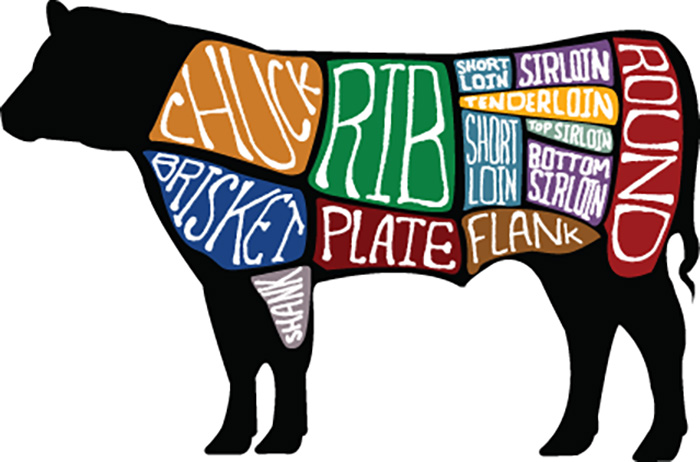
Chuck
Chuck, an area that’s impacted by daily exercise, is a popular section for ground beef. Chuck cuts are rich in collagen, which adds a great deal of flavor when cooked low and slow. Aside from burgers, these cuts perform at their highest when slow cooked with wet methods, like roasting, stewing, or braising. Chuck’s popularity is mostly attributed to its lower price point and limitless potential in recipes, not to mention its great grilling options: chuck eye steaks and flat irons. It’s easy to cook, tastes great, and is always available.
Ribs
Two incredible muscles from the rib area, the longissimus dorsi and the spinalis, are responsible for giving us ribeye steaks. Widely perceived as even a butcher’s favorite cut, our ribeyes are loaded with marbling, making them super juicy and flavorful. While most people prefer to broil or pan fry this particular cut, those who can handle tall flames may opt to fire up the grill. Start by getting your grill piping hot: +450°F. Sear on each side for about 2-3 minutes. Then, turn off the heat on one side of the grill, and set the ribeyes there to continue cooking. This will prevent the steaks from burning (unless a heavy char is your thing).
Avid campers who like sizzling steaks on their fires swear by using thick ribeyes on the bone for the great outdoors. The steaks’ marbling helps safeguard against overcooking, which is helpful when your amenities are at a minimum. Grilling tools should be kept at the ready, because when that much fat hits the fire, it’ll look like the pyrotechnics at a Kiss concert. For more tips on preparing other foods over a campfire, click here.
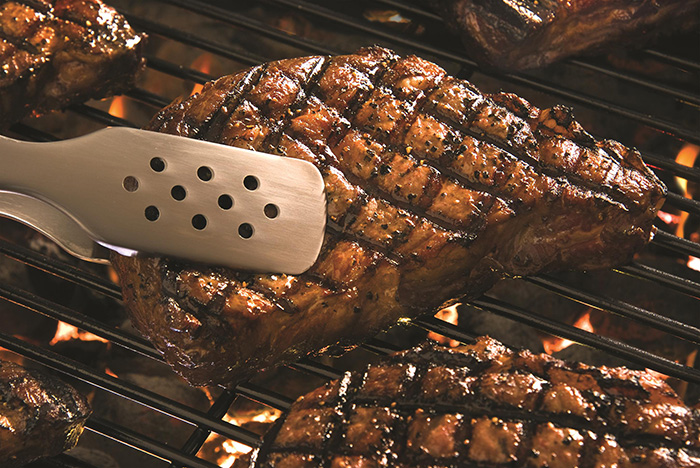
If you love traditional pork ribs, you may be interested in beef back ribs or beef short ribs. Back ribs, labeled as beef spare ribs in our meat cases, can be roasted, braised, or grilled. Beef short ribs, however, are best when braised or smoked—a process that may take hours of hands-off cooking to achieve the perfection you deserve. But as with any delectably seasoned rib meat, it’s worth the wait to achieve fall-off-the-bone bliss.
Short Loin & Sirloin
There’s a reason that cuts from the short loin and sirloin areas are more expensive: they are the most tender and coveted cuts of beef on the market. The popular porterhouse, T-bone, and tenderloin (aka filet mignon) all come from these areas, which typically earn the highest marks among steak aficionados.
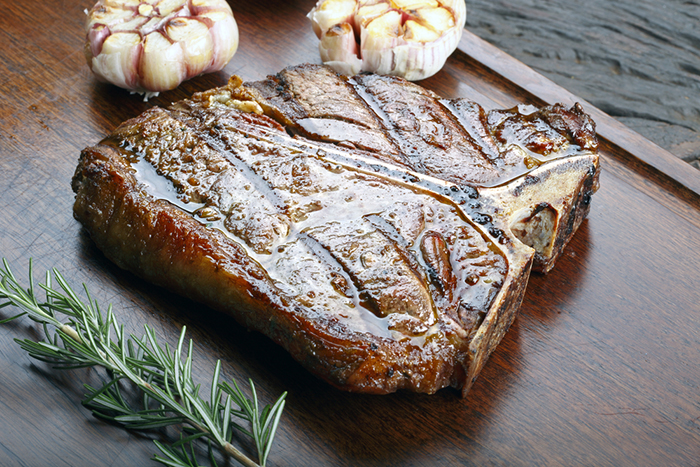
Short loin and sirloin perform well with marinades, sauces, or rubs, but even with just salt and pepper, they offer great flavor. The tenderloin’s flavor, however, is more reserved.
There’s no wrong way to cook sirloin or short loin steaks, but experts recommend searing them 2-3 minutes per side in a laser-hot, cast iron skillet coated with your favorite oil. Then, pop that skillet in the oven at 400°F for 4-5 minutes. This locks in the flavors on the front end, but also ensures the middle of the steak is cooked. Let the meat rest for a couple of minutes after you take it out of the oven. By the way, this is also a foolproof method for almost any steak or burger, but with a cut from the loin, it’s simply di(bo)vine!
Round
Rump roast comes from the round and is ideal for any dish that requires braising. Round cuts have intense flavor, but they are inherently tough due to less marbling. With our Certified Angus Beef ® brand cuts, however, you don’t have to worry about that as much, because marbling is its No. 1 standard for quality. Just cook low and slow.
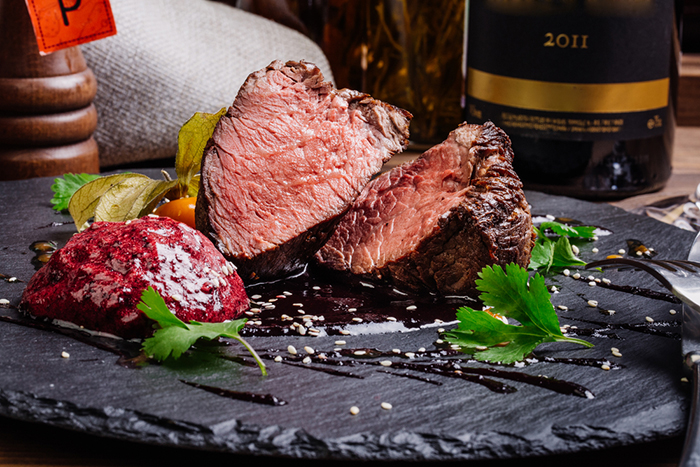
Cuts from the round are great for pot roasts or Italian beef. The top round is an excellent option for those recipes, as it’s the most succulent part of this section. Just before serving, be sure to cut the round in thin slices against the grain. This makes a big difference in the overall tenderness.
Shank
Cross-cut shanks are quite popular due to their fork-tender results and robust flavors. Since they come from the leg, the beef tends to be tough and sinewy due to higher levels of collagen. To cook past such flavors, cook shank cuts long and slow with moist heat. Soups and stews are often vastly improved when they incorporate shank as an ingredient.
Our chef partners from Certified Angus Beef ® crafted this Best Beef Pho recipe, proving that the right cooking method can turn a tough cut of meat into a superstar (even when it’s not in a lead role).
Flank & Skirt
Meat from the flank requires more planning if you’re looking to pull off a tender, delicious meal. Prior to cooking, you’ll want to marinate your flank steak for 24 hours. Use a marinade base with a little acid in it, like lemon juice or red wine vinegar, which will help break down the beef and make it more tender. Flank is very lean, so it tends to dry out fairly easily. For best results, cook beef to a medium degree of doneness (at most) and slice thinly against the grain after resting.
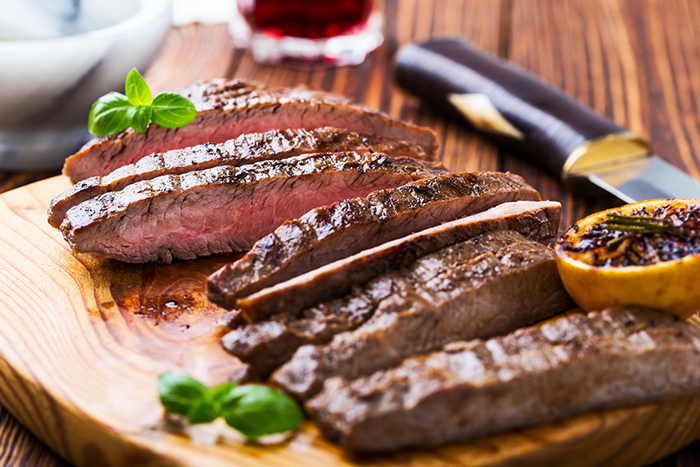
Skirt steak, a popular fajita meat, comes from the diaphragm muscle and is often confused with flank steak. If you happen to grab it by mistake, don’t fret: the inside skirt performs well, similarly to the flank steak, while the outside skirt is extremely tender and flavorful.
Brisket
From the very front comes the least tender cut of meat: brisket. Often used for corned beef, pastrami, and the very best barbecue, this cut is ideal for curing and smoking. It is also most popularly braised and slow cooked to take advantage of its high fat and collagen content. Is anyone getting hungry yet?
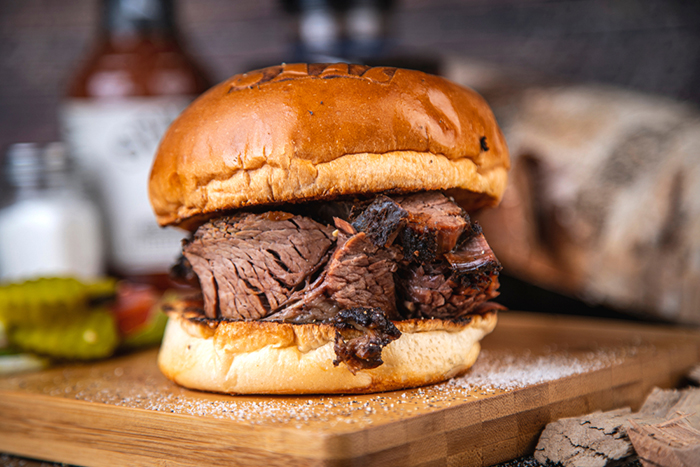
Brisket offers meat lovers an incredibly flavorful cut that’s vastly different from the usual steaks and burgers. For a more flavorful (yet fattier) brisket that’s ideal for shredding, be sure to ask for a point cut. The other popular choice is a flat-cut brisket, which houses less fat but is easier to slice.
At Pete’s Market, we are very proud of our meat departments. While we may have made some changes to our full service counters, please know that our in-house butchers are still in the back of the house cutting and packaging meat every day. We have simply adapted to consumer demands for quicker grab and go options. Our butchers are still available to answer questions, assist in your selections, and prepare our fine meats to your specifications. We also recommend visiting CertifiedAngusBeef.com for a variety of delicious, beef-centric recipes. Please tag us in your culinary adventures so we can come along for the ride.



